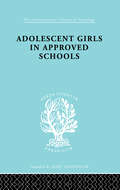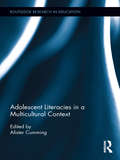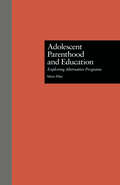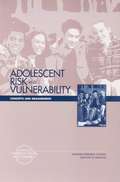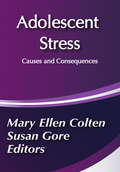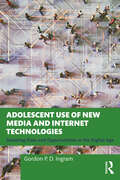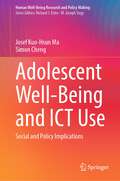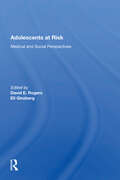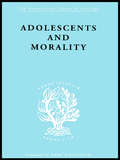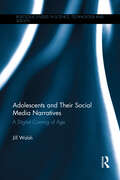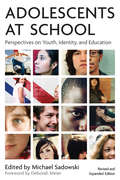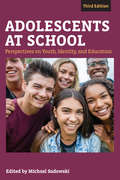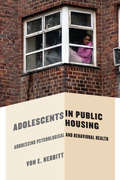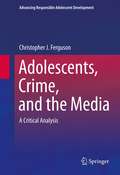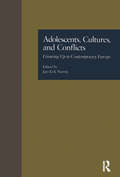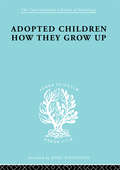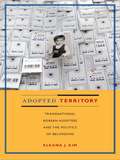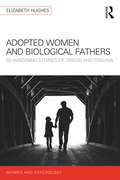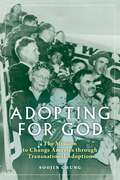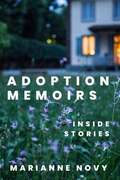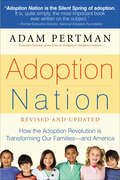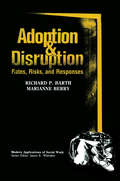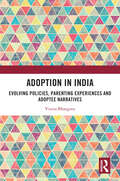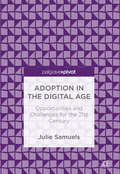- Table View
- List View
Adolescent Girls in Approved Schools (International Library of Sociology)
by Helen J. RichardsonThis is Volume I of twenty-eight in the Sociology of Education series. Originally published in 1969, Adolescent Girls in Approved Schools looks at the subject of delinquency in relation to women and girls.
Adolescent Literacies in a Multicultural Context (Routledge Research in Education)
by Alister CummingThis book presents results from a four-year project addressing the central question: What factors, challenges, and contexts contribute to and constrain literacy achievement among at-risk adolescent learners with culturally diverse backgrounds? Researchers consider the importance of several, interrelated factors that support the development of adolescents’ literacies in multilingual contexts: support from educators, community groups, families, and peers; recognition of the multi-faceted complexity of literacy through multiple, complementary methods of research and assessment; approaches to pedagogy that engage learners’ zones of proximal development in humanistic and purposeful ways; and promoting students’ vocabulary knowledge, strategies for reading, writing, and learning, and orientations to engaging with epistemic purposes of literacy critically, through multiple media, and with self-confidence.
Adolescent Parenthood and Education: Exploring Alternative Programs (MSU Series on Children, Youth and Families #2)
by Mary PilatFirst published in 1997. Routledge is an imprint of Taylor & Francis, an informa company.
Adolescent Risk And Vulnerability: Concepts And Measurement
by Board On Children Families YouthThe Board on Children, Youth, and Families was created in 1993. Its Committee on Adolescent Health and Development studies issues facing young people and their families using analytic tools from the behavioral, social, and health sciences. Four papers from the Committee's March 2001 workshop, held in Washington, D. C. , examine the beliefs underlying adolescents' decisions, present a framework for understanding the vulnerability of adolescents to undesirable outcomes, offer a model for estimating the economic payoffs for different types of policy actions designed to offset adolescent health risks, and discuss adolescents' concerns about their futures and well- being. This work lacks a subject index. Annotation c. Book News, Inc. , Portland, OR (booknews. com)
Adolescent Stress: Causes and Consequences (Social Institutions And Social Change Ser.)
by Mary ColtenAdolescent Stress concentrates on a range of major problems—those of a normal developmental nature as well as those of poor adaptation—identified in adolescents.
Adolescent Use of New Media and Internet Technologies: Debating Risks and Opportunities in the Digital Age
by Gordon P. IngramThis book engages with contemporary, and often polarizing, debates surrounding the risks of adolescent use of digital media and internet technologies. By drawing on multiple research studies, the text synthesizes current understandings of the impacts of social network use, online gaming, pornography, and phenomena, including cyberbullying, cyberstalking, and internet addiction, to develop recommendations for the effective identification of at-risk youth, as well as strategies for informed communication about online risks and opportunities. It shows how media discussion of risks to children and teenagers from new technology is highly emotive and often exaggerated, rooted in the “moral panic” surrounding new cultural practices that young people engage in, but which adults do not understand. Online risks are thus conceptualized as centering on three areas, specific to adolescence, which have undergone radical changes due to new internet technology. These include young people’s identity, the types of content that are accessed, and social relationships. The author shows how these matters stem from the potential of new technology to establish new interpersonal connections, emphasizing how it brings opportunities, as much as risks. As such, he provides a uniquely balanced discussion of potential dangers, while also emphasizing the opportunities for social, academic, and personal growth which new technologies afford young people. It will be indispensable for researchers and clinicians interested in assessing levels of online risk, as well as scholars and educators with interests in cyberpsychology, social psychology, cyber culture, social aspects of computing and media, and adolescent development.
Adolescent Well-Being and ICT Use: Social and Policy Implications (Human Well-Being Research and Policy Making)
by Simon Cheng Josef Kuo-Hsun MaIn this book, the authors expertly examine the issue of adolescent well-being in the light of their exposure to and use of information and communication technologies (ICTs) at school and home. The authors discuss a new form of inequality especially noticeable among youth, which is, digital inequality/divide, created through rapid developments in ICT. They analyze the relation between digital divide and educational inequality among youth, describe patterns of social exclusion from technology and education, and discuss related policies in industrialized nations to see how well-being issues can be addressed in this context. Comparing results based on nationally representative and internationally comparative datasets across 28 countries, the authors ask how and why the benefits accruing from ICT are substantially greater for some adolescents, but apparently smaller for others and how such differences may be reduced. They provide policy suggestions that are broadly based in the fields of well-being, secondary education, and technology use. This book is of interest to researchers and students of quality of life and well-being studies and a wide range of social science and education disciplines, including the sociology of education, media sociology, sociology of childhood and adolescence, communication studies, and science and technology education.
Adolescents At Risk: Medical and Social Perspectives
by David E. RogersThis text seeks to examine the factors that cause teenage violence, risky sexual behaviour (including risk of AIDS), and alcohol and drug abuse. It also addresses the guidelines that should be followed by those who seek to reduce societal costs resulting from the disfunctional behaviour of young people unable to make the transition from adolescence to young adulthood without special assistance and support.
Adolescents and Morality: A Study Of Some Moral Values And Dilemmas Of Working Adolescents In The Context Of A Changing Climate Of Opinion (International Library of Sociology)
by E.M EppelThe groundbreaking works in The Sociology of Youth and Adolescence set of the International Library of Sociology led the way to an authoritative understanding of how social interaction moulded young people. Careful observation of vulnerable and troubled children helped the leading sociologists, whose works are included in this set, to investigate how aggression, discipline, the struggle for recognition and the need to rebel shaped the personalities of the young. These are important texts for practitioners, students and teachers in health and social welfare.
Adolescents and Their Social Media Narratives: A Digital Coming of Age (Routledge Studies in Science, Technology and Society)
by Jill WalshAdolescents are forging a new path to self-development, taking advantage of the technology at their fingertips to produce desired results. In Adolescents and Their Social Media Narratives, Walsh specifically explores how social media impacts teenagers' personal development. Indeed, through unique empirical data, Walsh presents an aspect of teen media use that is not often documented in the press—the seemingly deep and meaningful process of evaluating the self visually in an attempt to reconcile their presentation with their internal "self-story." Nevertheless, as Walsh outlines, this is not a process without its challenges. Tracking teenagers’ progress towards self-validation from the offline stages preceding online exhibitions, this enlightening volume will appeal to undergraduate and postgraduate students, scholars, and researchers interested in fields such as Social Media Studies, Sociology of Adolescence, Identity Formation, Developmental Psychology, and Society and Technology.
Adolescents at School, Second Edition: Perspectives on Youth, Identity, and Education (Youth Development And Education Ser.)
by Michael SadowskiAs any teacher or parent knows, adolescence is a time when youth grapple with the question, &“Who am I?&” Issues of race, ethnicity, class, gender, sexual orientation, and ability can complicate this question for young people, affecting their schoolwork and their relationships with teachers, family, and peers. This new edition of Adolescents at School builds and expands the strengths and insights of the much-acclaimed first edition. Drawing from the perspectives of teachers, researchers, and administrators—and adolescents themselves—it examines the complex, changing identities young people manage while they confront the challenges of schools. A uniquely practical, insightful, and jargon-free volume, Adolescents at School points to ways to foster the success of every student in our schools and classrooms.
Adolescents at School, Third Edition: Perspectives on Youth, Identity, and Education (Youth Development and Education Series)
by Michael SadowskiAdolescents at School brings together the perspectives of scholars, educators, and researchers to address the many issues that affect adolescents&’ emerging identities, especially in relation to students&’ experience of and engagement with school. The book offers current and preservice teachers a practical understanding of the concept of identity development, particularly as impacted by such factors as race, ethnicity, gender, sexual orientation, ability/disability, immigration, and social class. This third edition includes new chapters on boys&’ emotional lives, risk and resilience in girls, the experiences of undocumented immigrant students, Muslim-American youth, and income inequality; features on &“teaching while white&”; and an extensively updated chapter on LGBTQ+ students. The book expands on the strengths and insights of the previous editions while also touching on issues highly relevant to contemporary youth such as social media, youth activism, and immigration. A practical and insightful volume, Adolescents at School points to ways to foster the success of every student in our schools and classrooms.
Adolescents at School: Perspectives on Youth, Identity, and Education
by Deborah Meier Michael SadowskiAs any teacher or parent knows, adolescence is a time when youth grapple with the question, “Who am I?” Issues of race, ethnicity, class, gender, sexual orientation, and ability can complicate this question for young people, affecting their schoolwork and their relationships with teachers, family, and peers. This new edition of Adolescents at School builds and expands the strengths and insights of the much-acclaimed first edition. Drawing from the perspectives of teachers, researchers, and administrators—and adolescents themselves—it examines the complex, changing identities young people manage while they confront the challenges of schools. A uniquely practical, insightful, and jargon-free volume, Adolescents at School points to ways to foster the success of every student in our schools and classrooms.
Adolescents in Public Housing: Addressing Psychological and Behavioral Health
by Von NebbittAdolescents in Public Housing incorporates data from multiple public-housing sites in large U.S. cities to shine much-needed light on African American youth living in non–HOPE VI public-housing neighborhoods. With findings grounded in research, the book gives practitioners and policy makers a solid grasp of the attitudes toward deviance, alcohol and drug abuse, and depressive symptoms characterizing these communities, and links them explicitly to gaps in policy and practice. A long-overdue study of a system affecting not just a minority of children but the American public at large, Adolescents in Public Housing initiates new, productive paths for research on this vulnerable population and contributes to preventive interventions that may improve the lives of affected youth.
Adolescents, Crime, and the Media: A Critical Analysis (Advancing Responsible Adolescent Development)
by Christopher J. FergusonA campus shooting. A gang assault. A school bus ambush. With each successive event, fingers are pointed at the usual suspects: violent films, bloody video games, explicit web sites. But to what extent can--or should--the media be implicated in youth crime? And are today's sophisticated young people really that susceptible to their influence? Adolescents, Crime, and the Media critically examines perceptions of these phenomena through the lens of the ongoing relationship between generations of adults and youth. A wealth of research findings transcends the standard nature/nurture debate, analyzing media effects on young people's behavior, brain development in adolescence, ways adults can be misled about youth's participation in criminal acts, and how science can be manipulated by prevailing attitudes toward youth. The author strikes a necessary balance between the viewpoints of media providers and those seeking to restrict media or young people's access to them. And the book brings scientific and intellectual rigor to culturally and politically charged issues as it covers: Violence in the media.Media portrayals of crime and youth.Research on violent television programs, video games, and other media as causes of crime.Effects of pornography on behavior.Public policy, censorship, and First Amendment issues.Adolescents, Crime, and the Media is an essential resource for researchers, graduate students, professionals, and clinicians across such interrelated disciplines as developmental psychology, sociology, educational policy, criminology/criminal justice, child and school psychology, and media law.
Adolescents, Cultures, and Conflicts: Growing Up in Contemporary Europe (MSU Series on Children, Youth and Families #Vol. 3)
by Jari-Erik NurmiFirst published in 1998. Adolescent development and well-being are both affected by socio-political change, political violence, immigrant status and various types of cultural, social and institutional diversity. These are realities faced by many adolescents in Europe today. This book examines these circumstances, and also the impact of recent socio-political changes in Eastern Europe and conflicts in Northern Ireland. Adolescent identities are looked at, as well as the effects of prejudice towards immigrant youths from their host societies.
Adopted Children Ils 123 (International Library of Sociology)
by Alexina M McWhinnieFirst published in 1998. Routledge is an imprint of Taylor & Francis, an informa company.
Adopted Territory: Transnational Korean Adoptees and the Politics of Belonging
by Eleana J. KimSince the end of the Korean War, an estimated 200,000 children from South Korea have been adopted into white families in North America, Europe, and Australia. While these transnational adoptions were initiated as an emergency measure to find homes for mixed-race children born in the aftermath of the war, the practice grew exponentially from the 1960s through the 1980s. At the height of South Korea’s “economic miracle,” adoption became an institutionalized way of dealing with poor and illegitimate children. Most of the adoptees were raised with little exposure to Koreans or other Korean adoptees, but as adults, through global flows of communication, media, and travel, they have come into increasing contact with each other, Korean culture, and the South Korean state. Since the 1990s, as Korean children have continued to leave to be adopted in the West, a growing number of adult adoptees have been returning to Korea to seek their cultural and biological origins. In this fascinating ethnography, Eleana J. Kim examines the history of Korean adoption, the emergence of a distinctive adoptee collective identity, and adoptee returns to Korea in relation to South Korean modernity and globalization. Kim draws on interviews with adult adoptees, social workers, NGO volunteers, adoptee activists, scholars, and journalists in the U. S. , Europe, and South Korea, as well as on observations at international adoptee conferences, regional organization meetings, and government-sponsored motherland tours.
Adopted Women and Biological Fathers: Reimagining stories of origin and trauma (Women and Psychology)
by Elizabeth HughesAdopted Women and Biological Fathers offers a critical and deconstructive challenge to the dominant notions of adoptive identity. The author explores adoptive women’s experiences of meeting their biological fathers and reflects on personal narratives to give an authoritative overview of both the field of adoption and the specific history of adoption reunion. This book takes as its focus the narratives of 14 adopted women, as well as the partly fictionalised story of the author and examines their experiences of birth father reunion in an attempt to dissect the ways in which we understand adoptive female subjectivity through a psychosocial lens. Opening a space for thinking about the role of the discursively neglected biological father, this book exposes the enigmatic dimensions of this figure and how telling the relational story of 'reconciliation' might be used to complicate wider categories of subjective completeness, belonging, and truth. This book attempts to subvert the culturally normative unifying system of the mother-child bond, and prompts the reader to think about what the biological father might represent and how his role in relation to adoptive female subjects may be understood. This book will be essential reading for those in critical psychology, gender studies, narrative work, sociology and psychosocial studies, as well as appealing to anyone interested in adoption issues and female subjectivity.
Adopting for God: The Mission to Change America through Transnational Adoption
by Soojin ChungExplores the role played by missionaries in the twentieth-century transnational adoption movement Between 1953 and 2018, approximately 170,000 Korean children were adopted by families in dozens of different countries, with Americans providing homes to more than two-thirds of them. In an iconic photo taken in 1955, Harry and Bertha Holt can be seen descending from a Pan American World Airways airplane with twelve Asian babies—eight for their family and four for other families. As adoptive parents and evangelical Christians who identified themselves as missionaries, the Holts unwittingly became both the metaphorical and literal parental figures in the growing movement to adopt transnationally. Missionaries pioneered the transnational adoption movement in America. Though their role is known, there has not yet been a full historical look at their theological motivations—which varied depending on whether they were evangelically or ecumenically focused—and what the effects were for American society, relations with Asia, and thinking about race more broadly. Adopting for God shows that, somewhat surprisingly, both evangelical and ecumenical Christians challenged Americans to redefine traditional familial values and rethink race matters. By questioning the perspective that equates missionary humanitarianism with unmitigated cultural imperialism, this book offers a more nuanced picture of the rise of an important twentieth-century movement: the evangelization of adoption and the awakening of a new type of Christian mission.
Adoption Memoirs: Inside Stories
by Marianne NovyAdoption Memoirs tells inside stories of adoption that popular media miss. Marianne Novy shows how adoption memoirs and films recount not only happy moments, but also the lasting pain of relinquishing a child, the racism and trauma that adoptees such as Jackie Kay and Jane Jeong Trenka experienced, and the unexpected complexities of child-rearing adoptive parents Emily Prager and Jesse Green encountered. Novy considers 45 memoirs, mostly from the twenty-first century, by birthmothers, adoptees, and adoptive parents, about same-race and transracial adoption. These adoptees, she recounts, wanted to learn about their ancestry and appreciated adoptive parents who helped. Birthmother Amy Seek shows why open adoption is not simple, and many other memoirs tell stories that continue past reunion. Adoption Memoirs will enlighten readers who lack experience with adoption and help those looking for a shared experience to also understand adoption from a different standpoint.
Adoption Nation: How the Adoption Revolution is Transforming Our Families—and America
by Adam Pertman“A treasure. It is the most complete book on adoption—ever—by one of the most eloquent, knowledgeable experts in the field.” —Sharon Roszia, co-author of The Open Adoption Experience and program manager of the Kinship CenterWith compassion for adopted individuals and adoptive and birth parents alike, Adam Pertman explores the history and human impact of adoption, explodes the corrosive myths surrounding it, and tells compelling stories about its participants as they grapple with issues relating to race, identity, equality, discrimination, personal history, and connections with all their families. For the first edition of this groundbreaking examination of adoption and its impact on us all, Pertman won awards from many organizations, including the American Academy of Child and Adolescent Psychiatrists, the Dave Thomas Center for Adoption Law, the American Adoption Congress, the Century Foundation, Holt International, and the US Congress. In this updated edition, Pertman reveals how changing attitudes and laws are transforming adoption—and thereby American society—in the twenty-first century.“Groundbreaking . . . courageous, penetrating, engaging, and deeply personal. —David Brodzinksy, Ph.D., co-author of Being Adopted: The Lifelong Search for Self“Creative, insightful, and a must-read.” —Ruth McRoy, Ph.D., co-author of Openness in Adoption: Exploring Family Connections“Pertman combines journalistic research and personal anecdotes in this stimulating overview of the trends and cultural ramifications of adoption.” —Publishers Weekly“A valuable experience for anyone, especially the adoptive parent.” —Kirkus Reviews
Adoption and Disruption: Rates, Risks, and Responses (Modern Applications Of Social Work Ser.)
by Richard P. BarthFirst Published in 2017. Routledge is an imprint of Taylor & Francis, an Informa company.
Adoption in India: Evolving Policies, Parenting Experiences and Adoptee Narratives
by Vinita BhargavaThis book highlights the complexities and multi-dimensionalities of child adoption in India by challenging the prevalent adoption theories. It is the only book to lend a voice to adopted children and adults. It foregrounds the narratives of many families in their experiences of adoption together with the author's personal account as an adoptive parent.The volume outlines parenting practices that lead to success and well-being achieved through adoption. The first unit deals with the 'macro' delineation of child adoption, while the second discusses the 'micro' concerns of parents and children in the Indian context. It also analyses the socio-political and socio-cultural contexts within which adoptions take place. It includes excerpts from the guidelines for in-country adoption, the Juvenile Justice Act and the Hague Convention on inter-country adoptions.This book would be useful to the students, researchers, and faculty of Social Work, Human Development, Education, Psychology, Sociology and Law. It will also be an indispensable companion to adoptive parents (domestic and inter-country), adoptees (domestic and abroad), psychologists, therapists, psychiatrists, and policy makers.
Adoption in the Digital Age: Opportunities and Challenges for the 21st Century
by Julie SamuelsAdoption in the Digital Age explores the transformation of adoption due to social and digital media technologies. The most prolific of these changes can be seen within contact arrangements, particularly those that are not managed by an intermediary, between adopted minors and their biological kin. Within this shift, it becomes clear that this often-breached contact arrangement lends itself towards discussions about further openness within adoption. At the same time these technologies continue to document the way adopted individuals and their biological kin feel about themselves and each other. It is for these reasons that the Internet remains both a promise and threat. Samuels explores this in detail, highlighting that what it means to be adopted continues to evolve in the context of networked media cultures. <P><P> Combining both theoretical discussions with the human experience of adoption, Adoption in the Digital Age will be of interest to students and scholars across a range of disciplines, including sociology, social work and cultural studies, as well as practitioners working with adoptive families and other members of the adoption triad connected and disconnected by adoption.
